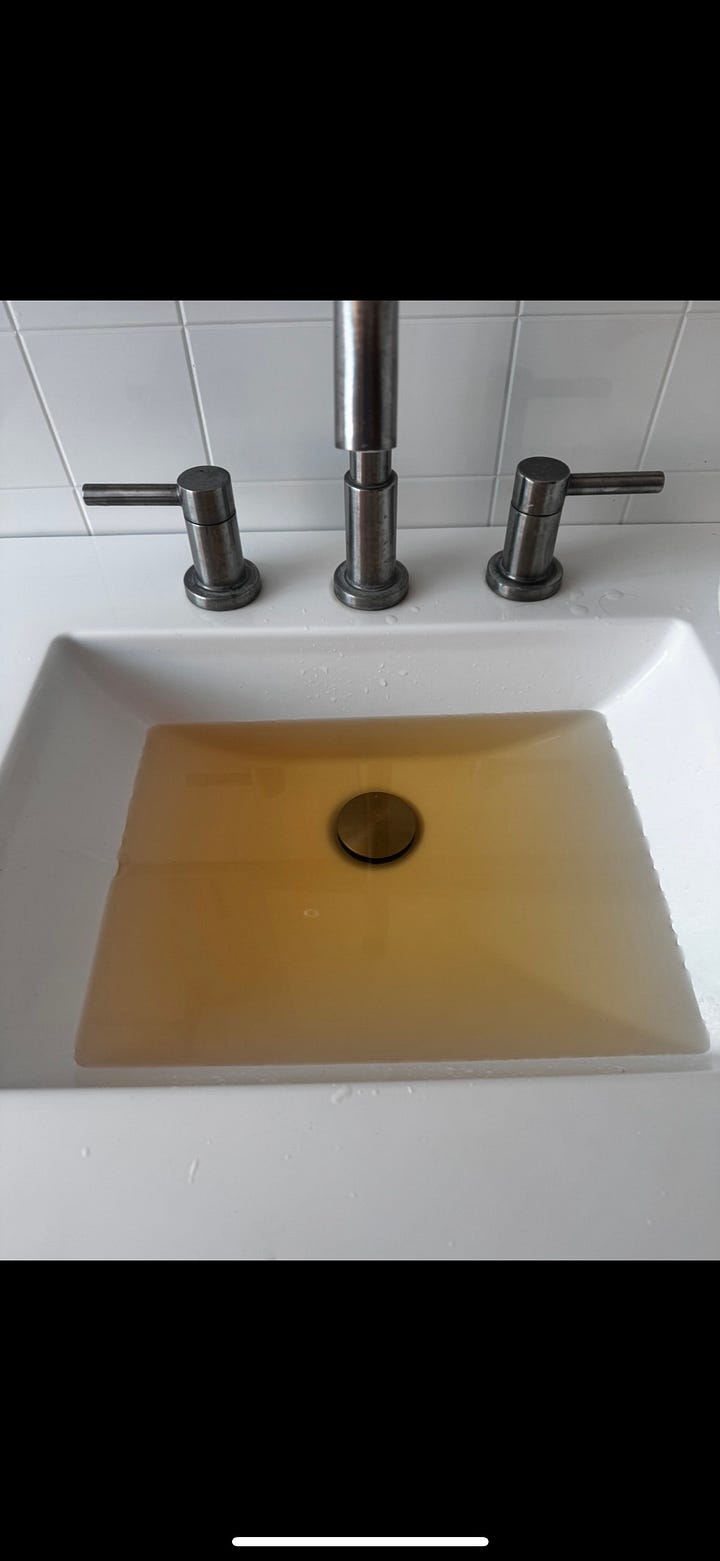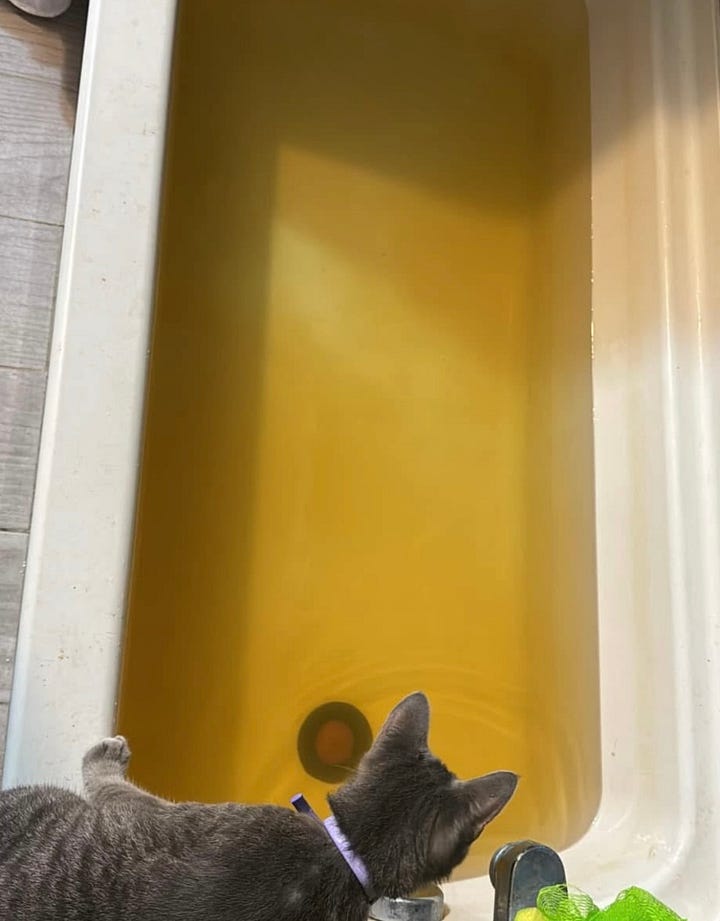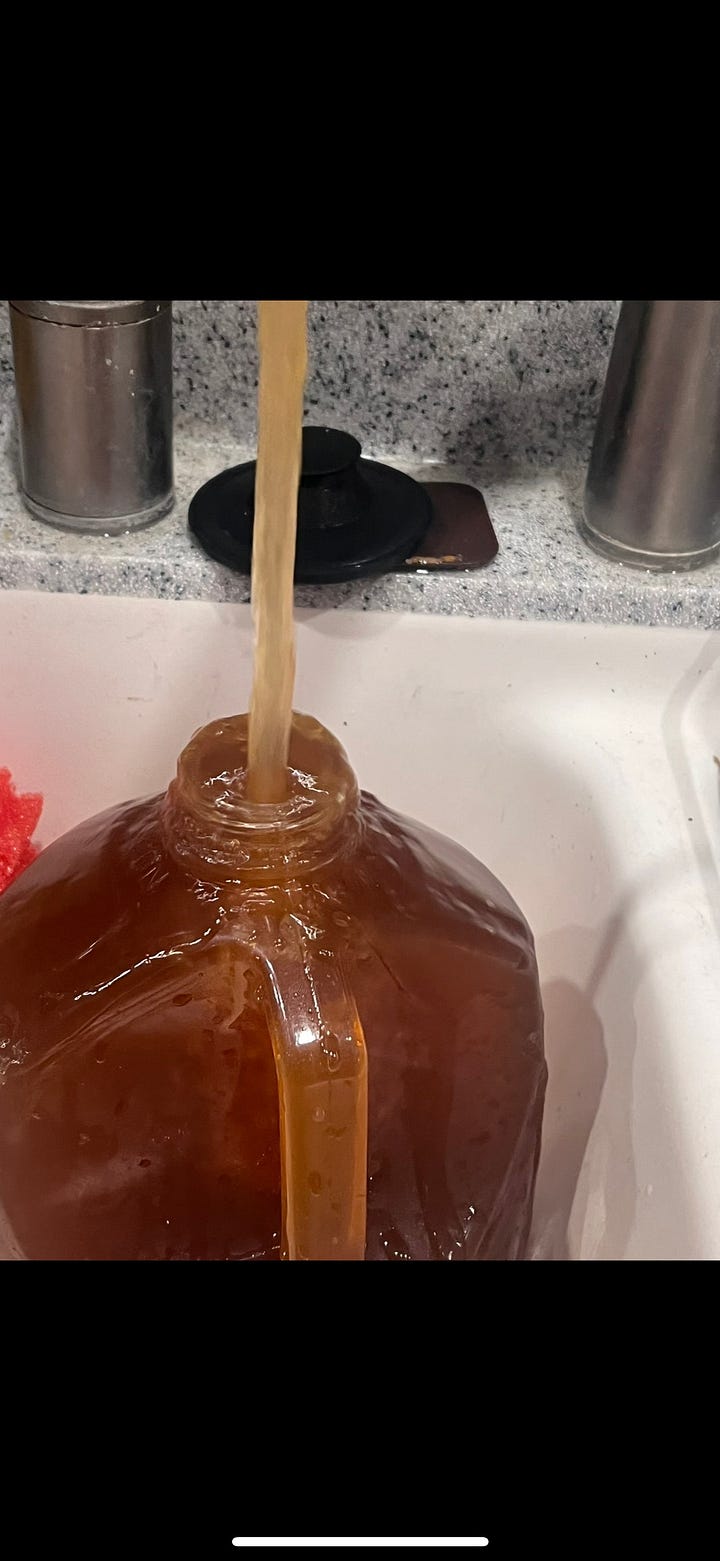Who's In Charge Of The Water In Madison County, Indiana?
Local Officials Fumble As Residents Raise Concerns About The Look Of Their Water




This story starts with Brianna Davis, who recently contacted me about discolored water issues in her town of Lapel, Indiana. It’s a small town with a little more than 2,000 residents, less than an hour from Indianapolis.
Bri is a young mom with two kids, who has lived in Madison County for five years, dealing with water that looks scary and undrinkable (see photos above). She says her water is often a fluorescent yellow hue, and she’s been collecting data on local Superfund and brownfield sites, images of the water, and more to try to understand what’s going on.
One Mother’s Fight for Answers
Like any concerned parent, Bri has contacted city officials, EPA, and her state environmental agency, the Indiana Department of Environmental Management (IDEM). She says the response has been confusing, and the problem persists.
City and county officials say the water is safe to drink, while IDEM and EPA representatives have told her it’s not advisable or safe to drink discolored water.
“I’m young.” she shared in a phone interview last week. “I hate when people don’t take me seriously. They act like nothing is wrong and act like I’m crazy.”
Her 70-pound pit bull mix died with an inflamed and oversized liver, along with elevated PFAS levels in his blood.
It might be easy to dismiss one person or household but online chatter in Facebook groups about the town and surrounding areas are also full of pictures from concerned citizens.
A Community Water Crisis Hidden in Plain Sight
We took a look at the 2021 Town of Lapel Comprehensive Plan and found this comment from a resident.
The entire water system needs repaired and revamped in the entire town of Lapel. The community residents need to feel safe about the water they are drinking and using for food preparation, as well as for cleaning their bodies.
Last week, at a Lapel Town Council Meeting, several residents shared their concerns as well.
Residents Speak Up at Town Council Meeting
Stephanie read an email she says she sent to the council, about concerns she’s had with the water for about five years.
“The water concerns in the town of Lapel are growing increasingly worse with people posting concerns about the color of their water,” she said.
She describes extreme discoloration in numerous local households.
“If one of you came home today and this was the color of your water, you would be gravely concerned for your own health and safety as it relates to this water,” she said.
Stephanie noted that when she washed her hands at the building where the meeting took place that night, even that water was yellow.
“Our town’s water concern must be put at the very top of the list of priorities above any other thing that you could possibly consider putting on a priority list,” she said. “Right now, nothing else should matter besides the health and safety of our local citizens.”
She shared that not everyone in town can afford a whole house reverse osmosis system, like the one she installed when she first started noticing the discoloration.
“To say that it is due to the flushing of the fire hydrants is not no longer acceptable,” she told the council. “The town was awarded a huge grant of money to fix this water concern and to be the solution. Obviously, something went sideways, and this is not the result that the leadership or town’s people expected or deserved. But this is not the fault of the residents. This falls back on the leadership. No one else in town was responsible for receiving of the grant or the disbursement of the money or the managing of the contract or what took place or did not. Besides the leaders of Lapel, the community counted on each one of you up at the front.”
I want to reiterate her point: the community is counting on its officials. When a water crisis hits, that’s what matters.
“The burden for the discoloration and concern for the Lapel water falls upon you as leaders,” she said. “What I want to know, as do many others in this town want to know right now, is what are you as a leader of this town doing to get to the bottom of why the water is like this and what is being done to fix it? Simply giving no answers and no resolution and communicating nothing is not acceptable. It's not acceptable behavior as a leader and it's not acceptable to the people. The local community deserves communication from the front of the room.”
She also mentioned that if there is action being done in the background that the leaders of the community should share that information too at the public meetings and in whatever means of communication used to get information to everyone.
Stephanie ended her remarks by saying that she is speaking out because of her concern for the community and her love for it.
“Doing nothing because we don't know is not an option,” she said. “It's no longer acceptable to let days and weeks and months pass by while community residents experience these water conditions you see week after week.”
Mike Helderbrand spoke next and brought a jug of yellow water that he said had just filled from his faucet at home.
He said simply, “don’t look too good to me.”
I agree, Mike. I agree!
The Runaround: When Reporting Problems Lead Nowhere
A council member responded to these concerns by saying, “If you have an issue, you have to call town hall and report the issue so we can come out and check it right away.”
They talk about how many complaints on water they are receiving and testing on a weekly average. Someone responds sounding a bit confused, but eventually says, “four yesterday, none today.”
The council member goes on to say, “If there is an issue that’s isolated to a street, talking about it on Facebook does no good to help us pinpoint the problem. We hire outside engineers to assist us with the water. We have an outside service that comes in and works with our water to make sure things are done correctly, and that we're following all procedures. All of our testing follows the state standards.”
But another woman comments that this process has not been fruitful, and then when people came out to test her water, they didn’t want to test her hose which had brown water coming out of it.
“We come to these meetings, you tell us to call us, when we do that, it’s not really an answer,” she said. “Maybe it’s time to say, ‘we don’t have one.’”
Funny, because on the agenda are quotes for a new well and to replace pumps in other wells. That indicates to me that the town knows that water issues exist. I’m just struggling to understand who’s in charge, and why the people in this town are getting the runaround.
Another mom took to the podium to discuss that her sons had to take a bath in the dirty, discolored water. She raised concerns that the water has ruined clothes that she has tried to launder in it. And she also asked about the schools and how they are monitoring the water.
All good points and questions. And I want to point out that these are the people who were able to attend the meeting. It can be tricky for many residents to get to a meeting if you have children, work a night job, have physical restrictions, or other conflicts.
A County Problem? Anderson Faces Similar Water Woes
The people of Lapel are not alone. In nearby, Anderson residents have reported brown, smelly water coming from their faucets and have similar concerns with their leadership.
In May, a newsletter from the town’s mayor claimed that the tap water remained, “safe for human consumption during flushing operations,” despite any discoloration. He emphasized that since taking office in 2016, $25 million has been invested in major improvements to ensure that the drinking water meets all safety standards.
The newsletter also discussed plans to invest $130 million during the next three years in “necessary” water improvements, some stemming from aging, nearly century-old infrastructure.
But the plan also includes a water rate increase to be phased in the coming five years to cover the cost of bond payments and increased water expenses.
Final Thoughts
What’s happening in Madison County represents a troubling pattern. Communities grappling with visibly contaminated water, while local officials offer conflicting information and residents feel dismissed and unheard.
In Lapel, yellow water flows from taps while city officials claim it's safe to drink, even as state and federal agencies advise against consuming discolored water.
Meanwhile, Anderson is planning $130 million in water infrastructure improvements while residents endure brown, foul-smelling water and rate increases.
These aren't isolated incidents. They are symptoms of aging infrastructure, inadequate oversight, and a disconnect between those in power and the people they serve. We have to account for older contamination sites that may now be causing problems as well. Many pollutants have a latency period of 20 years or more.
The residents of these communities deserve more than bureaucratic deflection; they deserve clean water, honest answers, and leaders who prioritize public health. When mothers don’t feel safe giving their children a bath, something is fundamentally broken—and it's not just the pipes.
Join the conversation below. Have you had discolored water issues where you live? What would you do if this water was coming out of your sink?



Live in Alexandria also in Madison County and we frequently experience discolored water as well. I have heard of many residents of the town getting their water tested with differing results. Personally we will not drink the water in our home.
My mom contracted an incurable disease at the age of 6 from groundwater contamination in 1960s in Anderson, Madison County, Indiana. I was forced to watch my mom and family suffer my entire life due to the damages the contaminated water caused. It was common knowledge in my family that the groundwater caused my mom's health problems. At the beginning of the Pandemic my mom was placed on the liver transplant list. She decided not to proceed with the surgery because it would lower her quality of life.
My mother Deborah Bilbrey Romine died 11/1/2024.
During the same time frame October-November 2024, the City of Anderson's Water Department Director Neal McKee said our finished water had tested high in PFAS for several years. I didn't put it together till Bri and I were doing all the research about Water Contamination. Once she found the Superfund Site Information that was the moment I realized the severity of the Water situation in Anderson, Indiana. We mapped the sites.
It was Feb-March 2025 when I learned that the Wheeler Ave Water Plant had been added to the Superfund Site in 2018. Then I saw the EPA Documents that showed that our water had been testing high in PFAS since the 80s. AND my mom just happened to drink the water at her home on the website that just happened to be located next to Superfund Site Prime Battery and a mile from ALAC. Plus, her tap came from the Wheeler Ave Water Plant.
April 2025, we had our EPA Meeting that they cancelled on us.
(Bri/Me & my husband Aaron/Callahan/Crumes/Etchison)
May 2025, The EPA realized they had to respond to all of us and had their own Town Hall. The Herald Bulletin wrote that we challenged them.
Now I know what I know, and I also figured out that the City of Anderson Government Officials allowed Homeless Encampments to sit on top of the NPL Superfund Site Pre-Pandemic. I took a group of volunteers back in the location in October 2023. The area was filled with water bottles full of pee, and misc. trash debris. We had to get the city involved and it cost taxpayers $100,000 to clean up. Fastforward and it took a handful of us to challenge the EPA for some answers to get any type of response.
Here we are, and my mom is also dead. I can't help but think the water helped kill my mom. AND by acquiesce City and County Officials have known the water is contaminated. Some of them have known since the 1960s, but local officials want to play coy. The kicker to all the funds we just got is that the infrastructure will still be running through the contaminated Wheeler Water Plant on the NPL Site until the NEW Water Plant is built.
The State officials recommended to put money into what we got and not build a new facility. Our water technically isn't getting fixed by City Officials, but it's great word play. People see all the money, and they think it's getting fixed. The reality is it's not getting fixed.
Then to top it off it will be another 2-4 years before the EPA makes a determination into who contaminated the water. Even though it was just as much the City of Anderson as it is the Businesses on the list of 100+ potential sources sent by way of email from Indiana House District 36 Kyle Pierce who has since recanted his email. We will be lucky if the EPA doesn't stall again or start back over from scratch as they throw out the other reports that cost us a lot of money when they were created. Back to square 0, and the people are getting screwed and not the elected officials or whoever is getting paid from the contracts.
Thank You!
11th Generation American Melungeon & Disgruntled Combat Veteran
Nicole (Schuyler) Kapuscinski